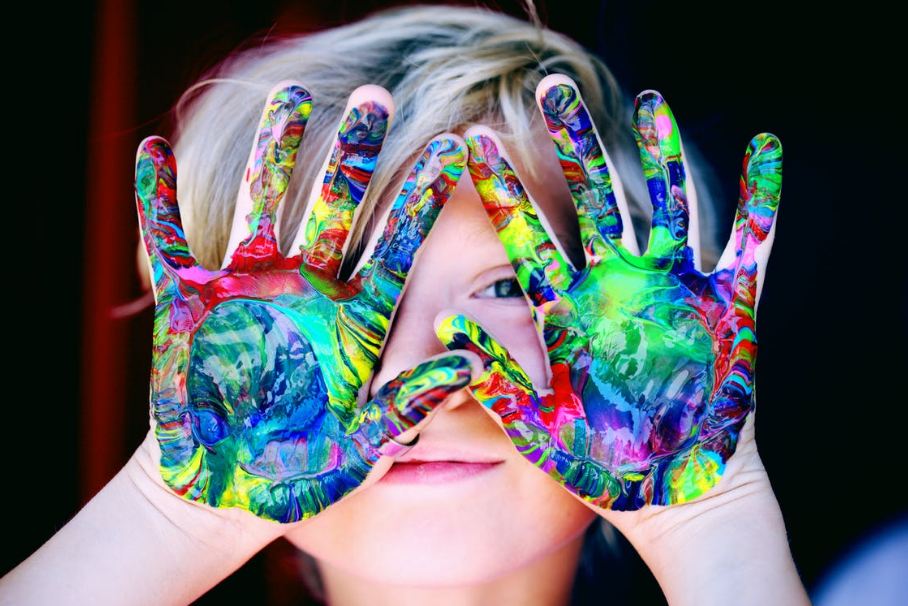How to Teach Your Child the Joys and Duties of Pet Ownership
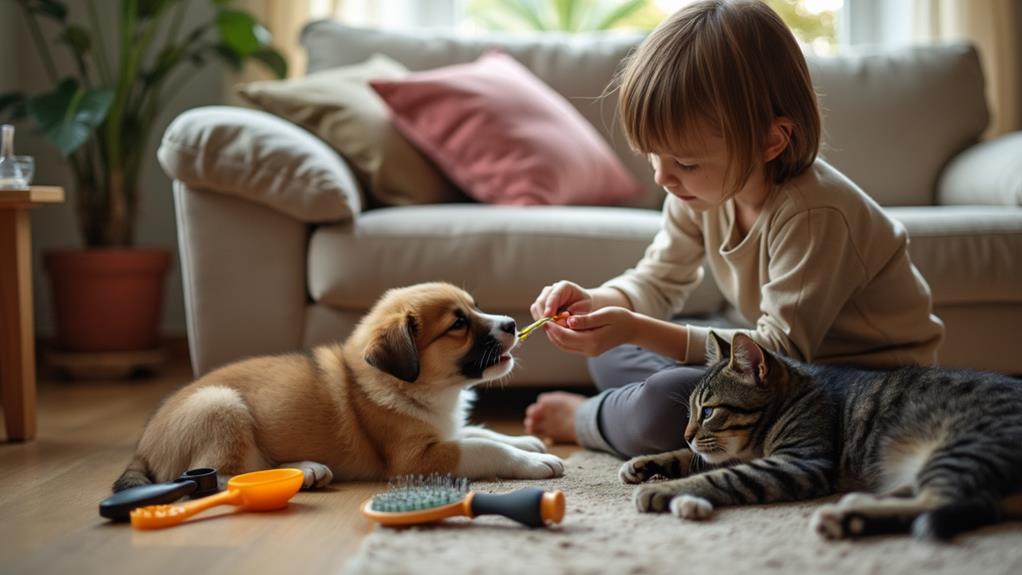
Teaching your child the joys and duties of pet ownership involves a balanced approach that combines fun with responsibility. Start with age-appropriate tasks, such as letting toddlers help with feeding or playtime. As they grow, increase their responsibilities to include activities like walking the dog or assisting with vet visits. Involving them in daily care routines and discussions about the pet's needs helps cultivate empathy and a sense of responsibility. To ensure these lessons are impactful and contribute to their emotional growth, consider these strategies:
- Consistency: Maintain a routine to help your child understand the importance of regular care.
- Education: Explain the reasons behind each task to deepen their understanding.
- Positive Reinforcement: Praise and reward your child for fulfilling their responsibilities.
- Role Modeling: Demonstrate proper pet care to set a good example.
- Supervision: Monitor their activities to ensure they are performed correctly and safely.
By integrating these strategies, you can enhance your child's learning experience and foster a lasting sense of responsibility and empathy towards animals.
Emotional Growth and Development
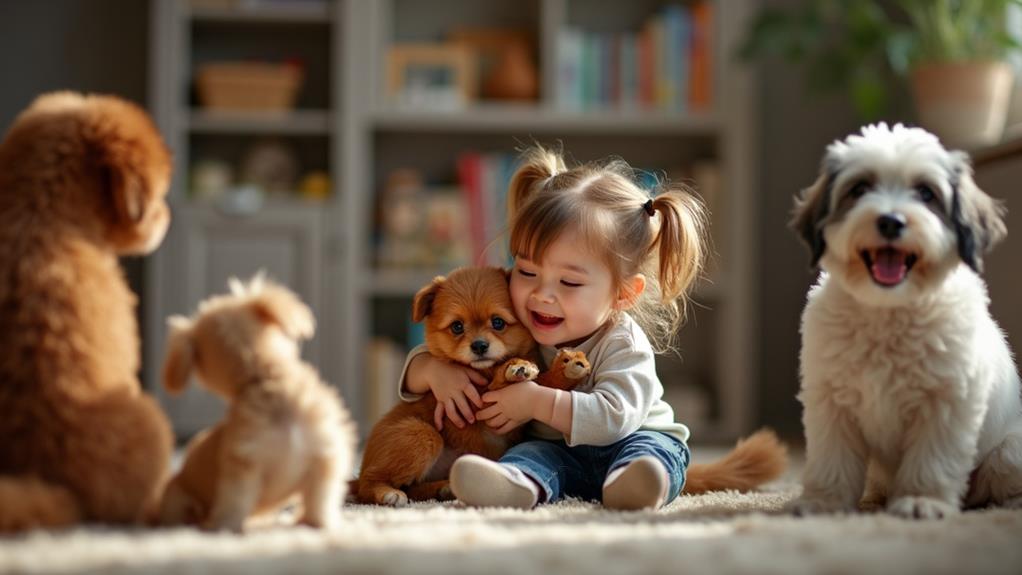
Teaching your child pet ownership is crucial for their emotional growth and development. When kids interact with pets, they experience a range of emotions such as joy, frustration, and even boredom. These interactions offer valuable opportunities for emotional expression and growth. By understanding and managing these feelings, children learn to recognize, control, and express their emotions, which is essential for their overall emotional development.
The responsibilities of pet ownership also cultivate qualities like patience, perseverance, and resilience. Caring for a living being requires dedication and effort, helping children build these traits over time. As they navigate these responsibilities, they develop a stronger sense of trust and respect, not only towards their pets but also in their relationships with others.
Pets can significantly reduce stress and anxiety in children, promoting healthier social interactions and emotional support systems. The emotional bonds formed between pets and children enhance feelings of security and empathy, contributing to their emotional growth. By taking on the responsibilities of pet care, children learn valuable life skills that benefit them in various aspects of their lives.
Age-Appropriate Pet Responsibilities
Introducing age-appropriate pet responsibilities can help your child develop essential caregiving skills. Toddlers can join you on walks, fostering early bonding. Children aged three to six can assist in feeding and playing with pets. As they grow older, preteens can take on more significant tasks like walking and brushing, always under your supervision to ensure safety for both the child and the pet.
Toddlers' Limited Involvement
Toddlers, generally under three years old, can begin learning about pet ownership through simple, age-appropriate tasks. Although they are too young for significant responsibilities, involving them in basic pet care activities can be beneficial. Supervised interactions are crucial to ensure both the toddler and the pet remain safe and happy.
Here are some ways toddlers can participate:
| Task | Description | Supervision Level |
|---|---|---|
| Accompany Walks | Walk with you and the pet, holding your hand | High |
| Give Water | Help pour water into the pet's dish | Moderate |
| Clean Dishes | Assist in washing pet dishes | High |
| Gentle Petting | Learn to gently pet and interact with the pet | Constant |
Encouraging your toddler to engage in these activities helps them develop empathy and a sense of responsibility. By helping with tasks like giving water or cleaning dishes, they start to understand the routine of pet care. It's essential to keep these tasks simple and always provide supervision to prevent any mishaps.
These small responsibilities foster a sense of belonging and connection to the family pet, setting the stage for more involved tasks as they grow older. Always prioritize safety and keep the activities enjoyable!
Early Childhood Tasks
Introducing young children to pet care responsibilities can be both rewarding and educational. For children under three years old, simply having them accompany you during pet walks can foster a sense of bonding and familiarity with animals. This early exposure sets the groundwork for more active roles as they grow older.
At the age of three, children can start taking on small yet significant tasks. Encourage them to play with the pet and help prepare food and water. These activities teach responsibility and promote a sense of care and empathy for the animal. Always supervise these interactions to ensure safety and effective learning.
Preteen Responsibilities Expansion
At the preteen stage, children are ready to adopt more complex pet care duties that build independence and accountability. Preteens can take on significant responsibilities, such as walking the pet, brushing its fur, and scheduling veterinary visits. These tasks foster a sense of responsibility and help them establish a routine.
Engaging preteens in pet training sessions can be incredibly beneficial. By teaching pets commands and behaviors, they improve their leadership skills and deepen their understanding of animal behavior. Additionally, involving them in budgeting for pet expenses—like food, grooming, and vet bills—introduces them to financial responsibility and planning.
Encourage your preteen to participate in pet socialization activities. These interactions help them develop interpersonal skills and understand the importance of proper pet interactions. Assigning the task of creating a pet care routine, including feeding schedules and exercise plans, instills a sense of commitment and long-term care awareness.
Essential Tips for Pet Ownership

Teaching your child about pet ownership is essential to ensure the well-being of the new pet and to instill a sense of responsibility and empathy in your child. It's crucial to emphasize that caring for a pet is a family responsibility, involving tasks like feeding, grooming, and vet visits.
Selecting the appropriate breed for your family is another important consideration. Different breeds have varying temperaments and energy levels, so choose one that aligns with your family's lifestyle and living situation to maintain a harmonious home environment.
Adoption is a commendable option, providing a loving home for an animal in need and teaching your child valuable lessons about compassion and responsibility.
Benefits of Pets for Children
Having a pet can significantly enhance a child's emotional and social development. Pets provide invaluable companionship, acting as steadfast friends that offer emotional support and friendship. This bond contributes to a child's overall well-being. With a pet around, children often have someone to confide in, which can enhance their emotional intelligence. Sharing secrets and feelings with a pet, who listens without judgment, allows children to better understand and manage their emotions.
Caring for a pet also teaches responsibility. Tasks like feeding, exercising, and grooming a pet require consistent effort and attention. By managing these duties, children learn vital life skills, including time management and the importance of caring for others. This sense of responsibility extends beyond pet care, positively influencing other areas of their lives.
Pets also improve children's social skills and self-esteem. Interaction with a pet encourages nurturing behaviors and empathy, fostering kindness and understanding towards others. Furthermore, the experience of loving and caring for a pet introduces children to meaningful life lessons, such as the concepts of life, death, and grieving. These lessons prepare them for future emotional challenges, making them more resilient and emotionally intelligent.
Educational Resources for Parents
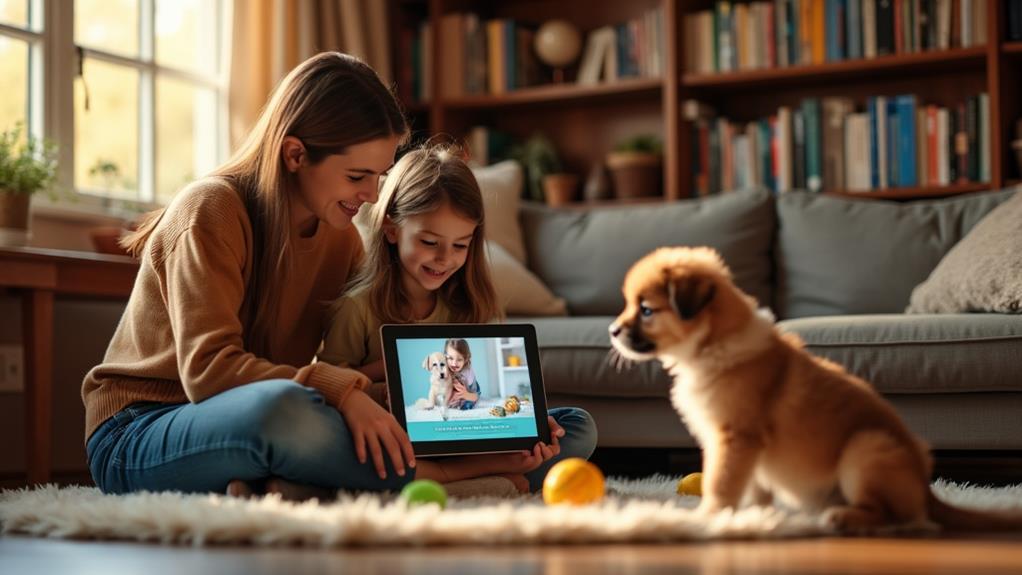
Understanding the benefits pets bring to children's development is crucial for parents looking to support this relationship effectively. Numerous educational resources are available to help your child appreciate the joys and responsibilities of having a family pet. These resources provide parents with insights into the emotional and developmental advantages pets offer, along with practical advice for fostering safe and positive interactions between children and animals.
Here are some valuable educational resources to consider:
- "We Are Family" Program: Offers materials to nurture healthy child-pet relationships, emphasizing emotional and developmental benefits.
- Risk Awareness Materials: Educate families on potential dangers to ensure safe interactions between children and pets.
- Skills Development Guides: Provide strategies for helping your child engage safely and positively with pets, thereby enhancing emotional enrichment.
- Companionship and Responsibility Guides: Inform expectant and new parents about the benefits of having pets, focusing on the companionship and sense of responsibility they bring.
Programs for Children
Programs for children play a crucial role in teaching kids about the responsibilities and joys of pet ownership. Initiatives like "Living Safely with Dogs" provide educational resources that help children learn how to interact safely with pets by emphasizing the importance of understanding animal behavior. Participation in these programs helps kids develop empathy, compassion, and respect for all living creatures.
The "Responsible Pet Ownership" curriculum is another excellent resource that educates children about the daily responsibilities of pet care, fostering a sense of accountability. Through this program, children learn the importance of providing consistent care and attention to their pets, ensuring their well-being.
Hands-on activities during school visits engage preschool and primary school children in practical lessons about pet care, making learning interactive and enjoyable. These activities enhance their understanding of animal welfare and responsible pet ownership.
Community involvement initiatives also play a significant role, encouraging kids to participate in pet education events. These events promote social skills and teamwork while instilling the values of responsible pet ownership. Overall, these programs equip children with the knowledge and skills to become compassionate and responsible pet owners.
Parental Guidance in Pet Ownership
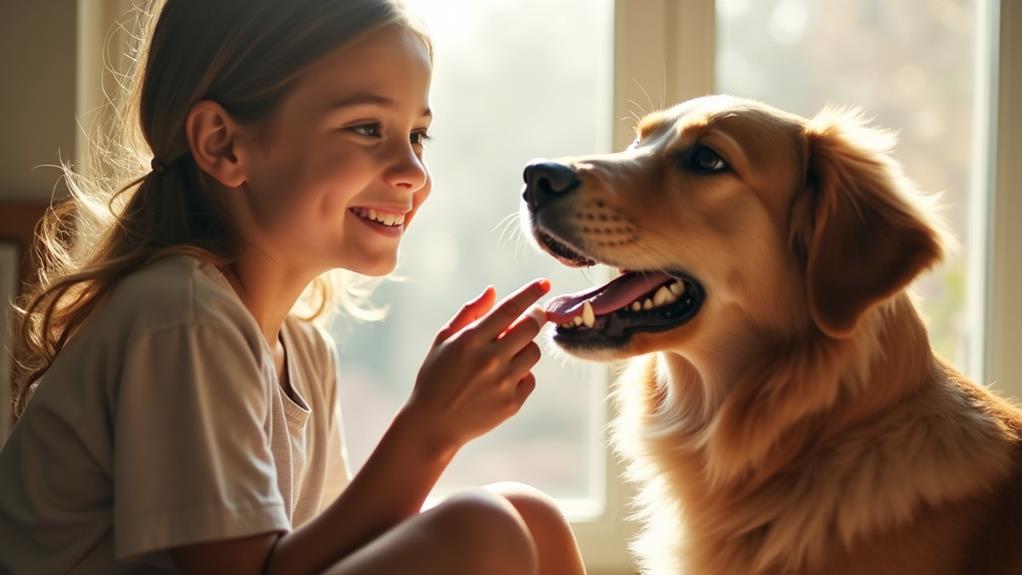
Parents play a crucial role in teaching children about the responsibilities of pet ownership, laying a foundation for understanding the needs of living beings. By modeling positive interactions with pets, parents can demonstrate empathy and respect, shaping their child's attitude toward animals. Early education on pet care responsibilities instills a sense of accountability in young children, encouraging them to take on specific tasks as they grow.
To effectively guide your child, you should:
- Model positive behavior: Show how to treat pets with kindness and respect.
- Assign appropriate tasks: Give young children simple responsibilities like refilling water bowls.
- Use verbal communication: Discuss your own experiences and feelings about pets.
- Reinforce lessons consistently: Regularly remind and encourage your child to complete their pet care tasks.
Engaging in discussions about feelings and experiences related to pets supports your child's emotional growth and understanding of the pet-owner relationship. By taking an active role and using verbal communication, parents can foster a strong emotional connection and sense of accountability in their child. Consistent guidance ensures these lessons become ingrained, helping children grow into compassionate and responsible pet owners.
Fun Activities With Pets
Engaging in fun activities with pets strengthens the bond between children and their furry friends while promoting physical activity and creativity. Games like fetch or hide-and-seek encourage both to be active together, making exercise enjoyable. Using positive reinforcement, such as praise or treats, can enhance this interaction and teach children the value of rewarding good behavior.
Creative play offers another excellent way to connect. Dressing pets in costumes or setting up obstacle courses fosters children's imagination and improves their interaction skills with animals. Including family members can turn these activities into a delightful group effort.
Outdoor activities like nature walks or park trips provide more than just exercise. They offer opportunities for pets to socialize and help children develop social skills in a relaxed environment. Including pets in family outings or picnics teaches children about sharing and caring while allowing pets to explore new surroundings.
Lifelong Lessons From Pet Ownership
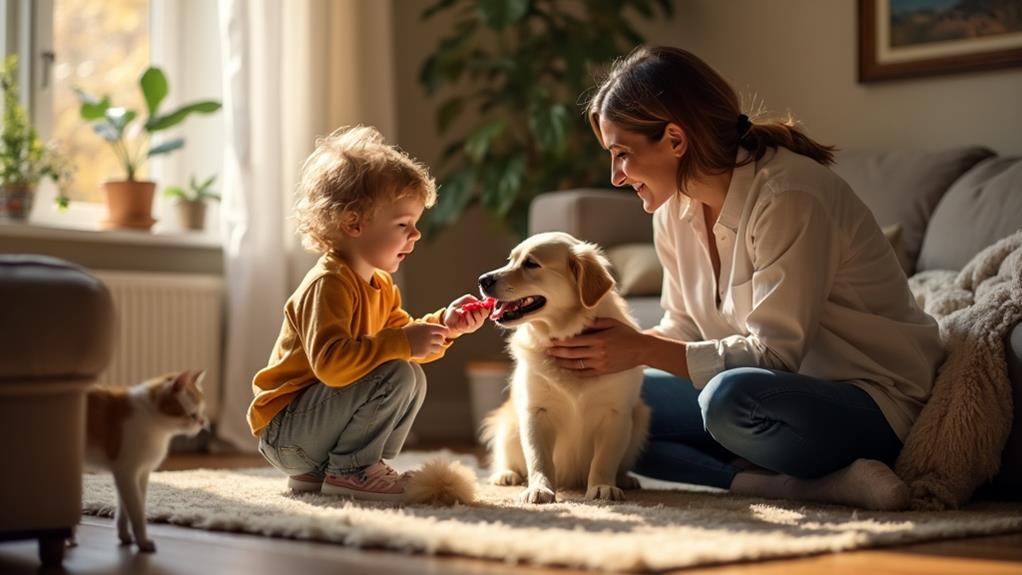
Engaging in fun activities with pets not only creates joyful memories but also imparts lifelong lessons. Teaching your child the responsibilities of pet care fosters a sense of accountability that extends to various life aspects. Tasks such as feeding, grooming, and regular walks instill the importance of routine and commitment.
Through nurturing a pet, children develop empathy and emotional intelligence, learning to understand and respond to their pet's needs. This skill enhances their ability to form strong interpersonal relationships. Additionally, experiencing a pet's life cycle, including concepts of life and death, builds resilience and helps children cope with grief and loss.
Consider the valuable lessons your child can learn:
- Responsibility: Daily tasks like feeding and grooming teach commitment.
- Empathy: Understanding and responding to a pet's needs builds emotional intelligence.
- Resilience: Coping with the life cycle of pets fosters strength in dealing with loss.
- Animal Welfare: Positive experiences instill a lifelong appreciation for caring for animals.
These lessons prepare your child for future challenges and relationships, enriching their emotional and social well-being.



